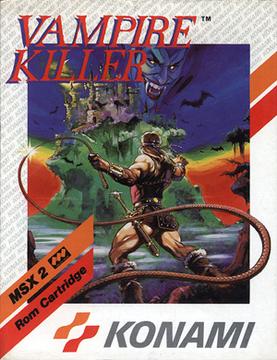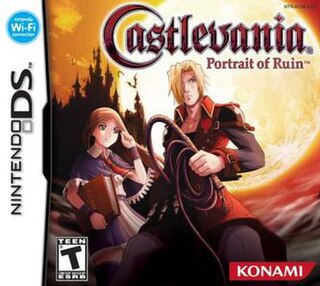
Castlevania, known in Japan as Akumajō Dracula, is a gothic horror action-adventure video game series and media franchise created by Konami. The series is largely set in the castle of Count Dracula, the arch-enemy of the Belmont clan of vampire hunters.
Ys is a Japanese series of action role-playing games developed by Nihon Falcom. The series chronicles the life of the adventurer Adol Christin.

Castlevania: Lament of Innocence is a 2003 action-adventure game developed by Konami Computer Entertainment Tokyo and published by Konami for the PlayStation 2 console. Part of Konami's Castlevania video game series, it is the first installment of the series on the PlayStation 2 and the third to make use of a 3D style of gameplay. It was released in Japan and North America in late 2003 and Europe and Australia in early 2004.

Castlevania: Symphony of the Night is a 1997 action role-playing game developed and published by Konami for the PlayStation and Sega Saturn. It was directed and produced by Toru Hagihara, with Koji Igarashi acting as assistant director. It is a direct sequel to Castlevania: Rondo of Blood, taking place four years later. It features Dracula's dhampir son Alucard as the protagonist, rising from his slumber to explore Dracula's castle which resurfaced after Richter Belmont vanished. Its design marks a break from previous entries in the series, re-introducing the exploration, nonlinear level design, and role-playing elements first experimented with in Castlevania II: Simon's Quest.

Castlevania: Rondo of Blood, originally released in Japan as Akumajō Dracula X: Chi no Rondo, is a 1993 action-platform game developed by Konami for the PC Engine's Super CD-ROM² System directed by Toru Hagihara. Part of the Castlevania series, protagonist Richter Belmont goes to save his lover Annette, who was abducted by Dracula. It was first released exclusively in Japan on October 29, 1993. A direct sequel, Castlevania: Symphony of the Night, was released worldwide in 1997.

Castlevania II: Simon's Quest is a 1987 action role-playing game developed and published by Konami. It was originally released in Japan in 1987 for the Famicom Disk System, and in North America in 1988 for the Nintendo Entertainment System. It is the second Castlevania game released for the NES, following the original Castlevania (1986). Set seven years after the events of the first installment, the player once again assumes the role of vampire hunter Simon Belmont, who is on a journey to undo a curse placed on him by Dracula at the end of their previous encounter. Dracula's body was split into five parts, which Simon must find and bring to the ruins of Castle Dracula in order to defeat him. The game deviates from the traditional platforming of its predecessor, incorporating role-playing and open world elements.

Castlevania: Circle of the Moon, titled Castlevania in PAL regions, is a 2001 action role-playing game developed and published by Konami as a launch title for the Game Boy Advance. Part of the Castlevania video game series, the game follows a vampire hunter named Nathan Graves as he attempts to rescue his mentor from the clutches of Dracula. The events of its plot were retconned by former Castlevania producer Koji Igarashi, a move which was met with some criticism.

Vampire Killer, known in Japan as Akumajō Dracula, is a 1986 platform game developed and published by Konami for the MSX2. It is a parallel version of the original Castlevania, which debuted a month earlier for the Famicom Disk System under the same Japanese title. However, the MSX2 version was localized first in Europe and was published without the Castlevania branding that the franchise would start using abroad in 1987 when the NES version was released in North America. It was released on the Wii U's Virtual Console on December 17, 2014, in Japan.

Castlevania: Dawn of Sorrow is a 2005 action role-playing game developed and published by Konami. It is part of Konami's Castlevania video game series and the first Castlevania game released on the Nintendo DS. The game is the sequel to Castlevania: Aria of Sorrow and incorporates many elements from its predecessor. Dawn of Sorrow was commercially successful. It sold more than 15,000 units in its first week in Japan and 164,000 units in the United States during the three months after its initial release.

Castlevania, also referred to as Castlevania 64, is a 1999 action-adventure game developed by Konami's Kobe branch for the Nintendo 64. An expanded version of the game, Castlevania: Legacy of Darkness, was released later in the same year.

Castlevania: Legacy of Darkness is a 1999 action-adventure game developed and published by Konami for the Nintendo 64. A prequel and expanded version of Castlevania, also released on the Nintendo 64 earlier the same year, it contains a revision of the original game with improved graphics, added villains, and alternate versions of some levels.

Castlevania Legends is a 1997 action-platform game developed and released by Konami for the Game Boy. The third Castlevania game released for the system, the story follows Sonia Belmont, a vampire hunter battling the first incarnation of Count Dracula. The game was conceived as a prequel to all other games in the Castlevania series; however, it later became recognized as non-canon.

Super Castlevania IV is a 1991 action-platform game developed and published by Konami for the Super Nintendo Entertainment System. It has been re-released multiple times, including for the Super NES Classic Edition.

Haunted Castle is a 1987 action-platform game developed and released by Konami for arcades. It is the second arcade game in the Castlevania franchise, following Vs. Castlevania, an arcade port of the original 1986 NES video game released in North America. Unlike the previous arcade title in the franchise, Haunted Castle is not a direct port of an existing console game, but a newly-developed arcade game running on a custom JAMMA-based board. The game has the player controlling Simon Belmont, who embarks on a journey to save his wife Selena from the clutches of Dracula.

Castlevania: Bloodlines, known in Japan as Vampire Killer and in PAL regions as Castlevania: The New Generation, is a 1994 action-platform game developed and published by Konami for the Sega Genesis as part of the Castlevania series. A vampire named Elizabeth Bartley is orchestrating the beginning of World War I to serve as the catalyst for the resurrection of her uncle, Dracula. Players take on the role of Quincey Morris' son, John, and his friend Eric Lecarde to take up the fight against evil.

Castlevania: Portrait of Ruin is a 2006 action role-playing game developed and published by Konami. The game was released on November 16, 2006 in Japan, and in North America on December 5, 2006 for the Nintendo DS handheld game console. Portrait of Ruin is the first Castlevania to feature a cooperative multiplayer gameplay mode and the first handheld Castlevania to have English voice-overs, outside of its original Japanese release.

Konami Wai Wai World, "wai wai" being a Japanese onomatopoeia expressing a noisy or boisterous atmosphere, is a 1988 Family Computer platform video game released only in Japan by Konami. The game itself stars various Konami-created characters as well as Mikey and King Kong, who appeared in two Konami-produced, film-based games.

Getsu Fūma Den is an action role-playing video game developed and published by Konami for the Family Computer in 1987 exclusively in Japan. It has been referenced in many subsequent Konami titles throughout the years. The game is structurally similar to Castlevania II: Simon's Quest, The Goonies II and Teenage Mutant Ninja Turtles (NES).

Castlevania, known in Japan as Akumajō Dracula, is a 1986 action-platform game developed and published by Konami. It was originally released in Japan for the Famicom Disk System in September 1986, before being ported to cartridge format and released in North America for the Nintendo Entertainment System (NES) in 1987 and in Europe in 1988. It was also re-issued for the Family Computer in cartridge format in 1993. It is the first installment in the Castlevania series.



















